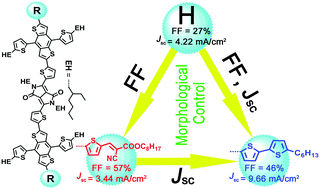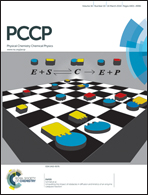Tuning morphology and photovoltaic properties of diketopyrrolopyrrole-based small-molecule solar cells by taloring end-capped aromatic groups†
Abstract
In this article, we selected BDT–DPP–BDT (DPP = diketopyrrolopyrrole and BDT = 4,8-di-2-(2-ethylhexyl)-thienyl-benzo[1,2-b:4,5-b′]dithiophene) as the model backbone and end-capped it with hydrogen, octyl 2-cyano-3-(thiophen-2-yl)acrylate (CNR), and 2-hexylbithiophene (HTT), respectively, forming three small molecule donors: BDB, CNRBDB and HTTBDB. Introduction of a polar and planar electron-withdrawing unit of CNR to both ends of the BDB backbone enhances the hole mobility from 4.14 × 10−4 to 7.75 × 10−3 cm2 V−1 s−1 and raises the fill factor from 27 to 57% when blended with PC71BM. This is associated with the PC71BM phase size decreasing from 70 to 20 nm. When the electron-donating unit of HTT with poorer planarity is linked to both ends of the BDB backbone, both donor and acceptor phase sizes are decreased to 20 nm. The short-circuit current density is greatly improved from 4.22 to 9.66 mA cm−2, and the fill factor is enhanced to 46%. Overall, this work demonstrates that the end-capped aromatic groups play an important role in tuning the phase size and photovoltaic properties of DPP-based small molecule solar cells.


 Please wait while we load your content...
Please wait while we load your content...